University Presentation: Project Negotiation, Conflict, and Engagement
VerifiedAdded on 2020/05/08
|11
|1534
|141
Presentation
AI Summary
This presentation explores project negotiation, conflict management, and stakeholder engagement within government and non-government projects. It delves into project life cycle theories, including linear and recursive perspectives, and examines operational functioning of contractual agreements. The presentation highlights the importance of stakeholder analysis, including identifying competing agendas and influencing factors. It covers various negotiation methods, conflict management strategies, and the application of project management tools like Gantt charts and real-time dashboards. Consequences of project delays, termination of arbitration rules, and the significance of asset life cycles are also discussed. The presentation emphasizes communication with stakeholders and concludes by underscoring the importance of effective negotiation and conflict resolution in achieving project success.
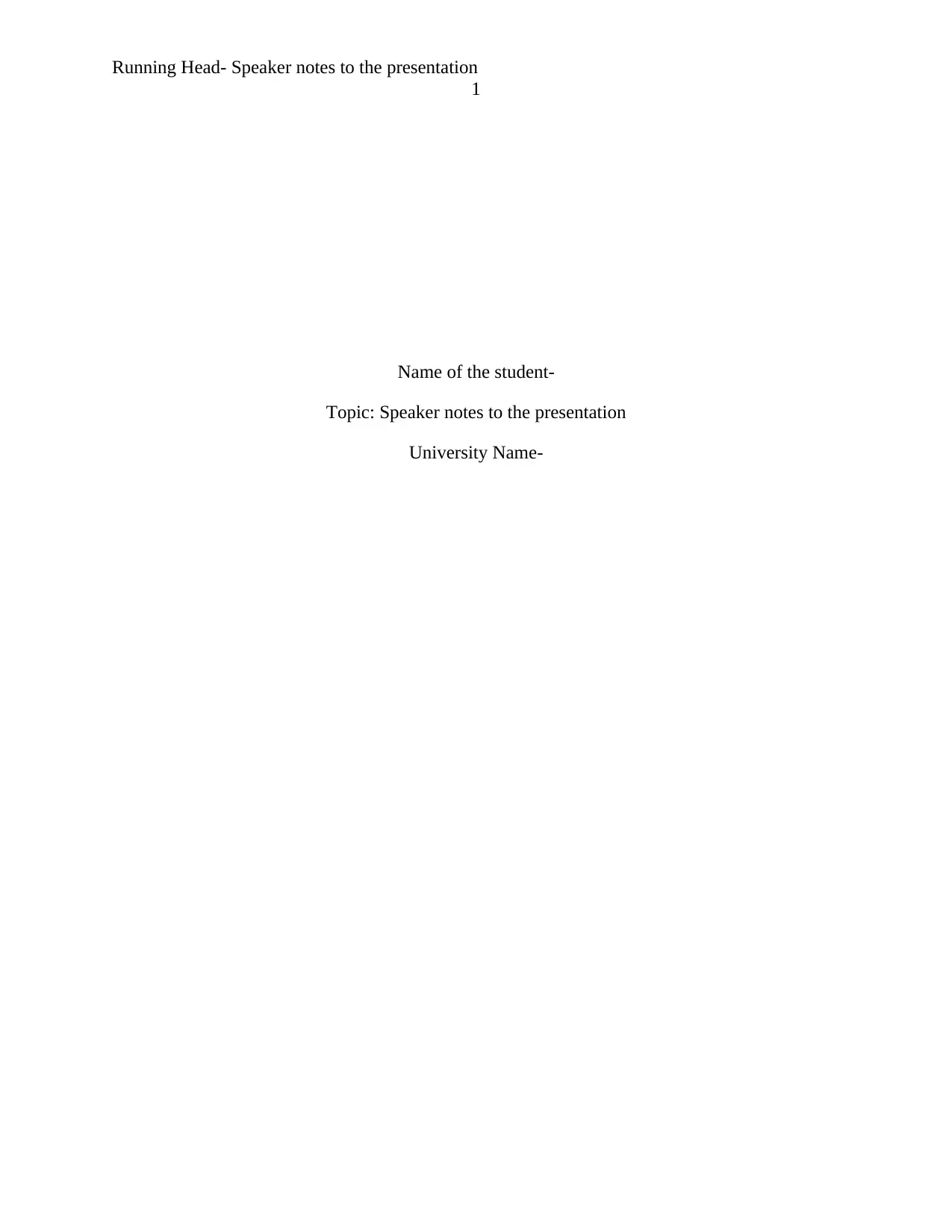
Running Head- Speaker notes to the presentation
1
Name of the student-
Topic: Speaker notes to the presentation
University Name-
1
Name of the student-
Topic: Speaker notes to the presentation
University Name-
Paraphrase This Document
Need a fresh take? Get an instant paraphrase of this document with our AI Paraphraser
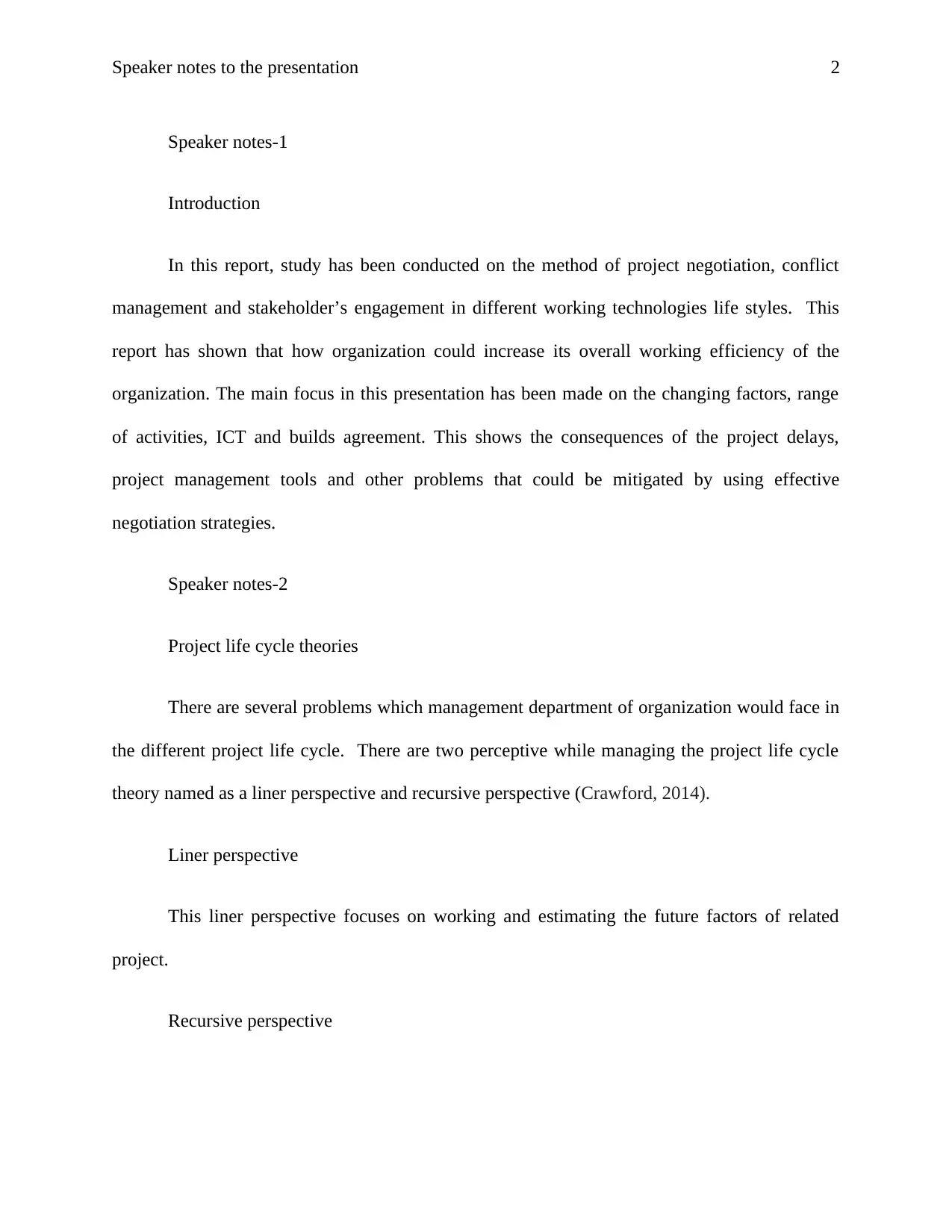
Speaker notes to the presentation 2
Speaker notes-1
Introduction
In this report, study has been conducted on the method of project negotiation, conflict
management and stakeholder’s engagement in different working technologies life styles. This
report has shown that how organization could increase its overall working efficiency of the
organization. The main focus in this presentation has been made on the changing factors, range
of activities, ICT and builds agreement. This shows the consequences of the project delays,
project management tools and other problems that could be mitigated by using effective
negotiation strategies.
Speaker notes-2
Project life cycle theories
There are several problems which management department of organization would face in
the different project life cycle. There are two perceptive while managing the project life cycle
theory named as a liner perspective and recursive perspective (Crawford, 2014).
Liner perspective
This liner perspective focuses on working and estimating the future factors of related
project.
Recursive perspective
Speaker notes-1
Introduction
In this report, study has been conducted on the method of project negotiation, conflict
management and stakeholder’s engagement in different working technologies life styles. This
report has shown that how organization could increase its overall working efficiency of the
organization. The main focus in this presentation has been made on the changing factors, range
of activities, ICT and builds agreement. This shows the consequences of the project delays,
project management tools and other problems that could be mitigated by using effective
negotiation strategies.
Speaker notes-2
Project life cycle theories
There are several problems which management department of organization would face in
the different project life cycle. There are two perceptive while managing the project life cycle
theory named as a liner perspective and recursive perspective (Crawford, 2014).
Liner perspective
This liner perspective focuses on working and estimating the future factors of related
project.
Recursive perspective
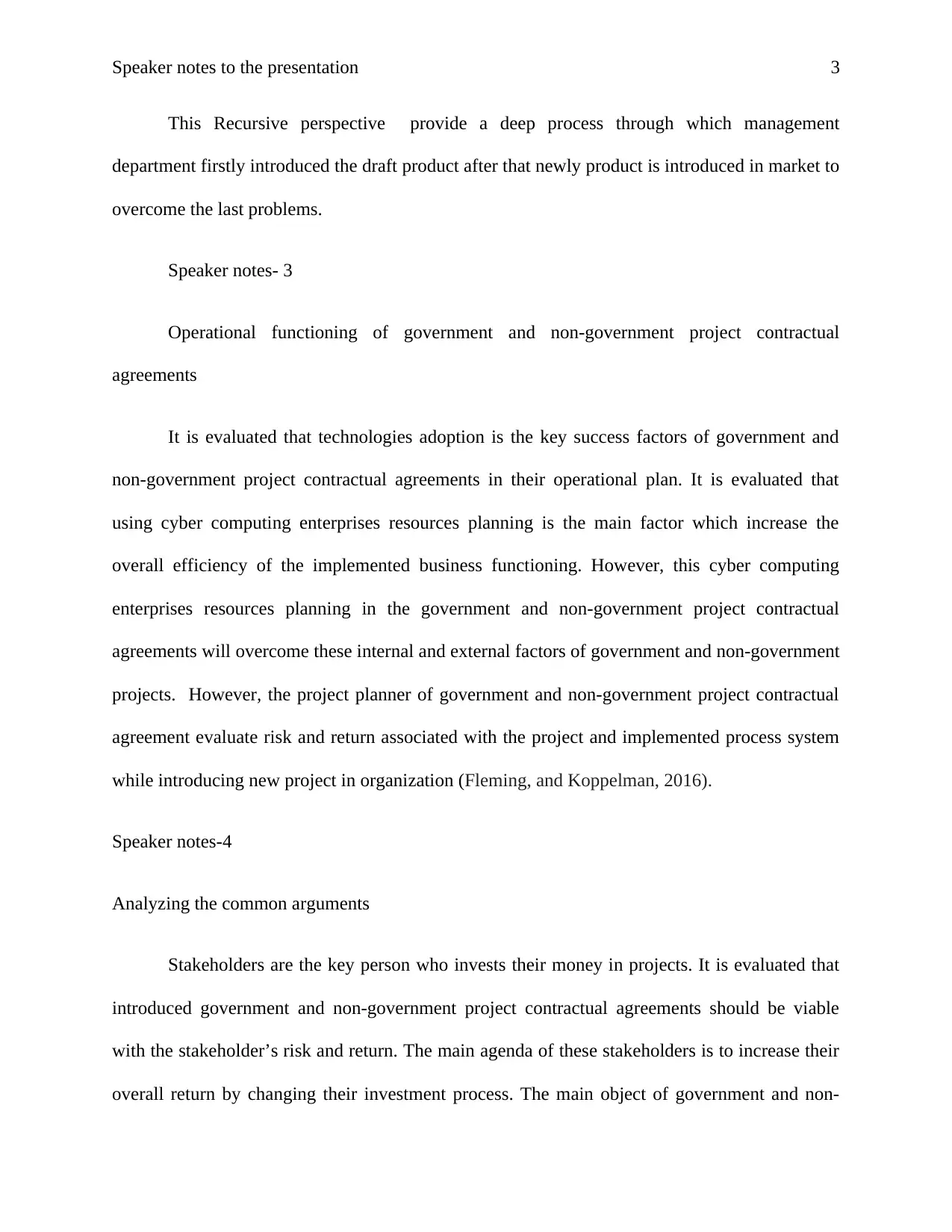
Speaker notes to the presentation 3
This Recursive perspective provide a deep process through which management
department firstly introduced the draft product after that newly product is introduced in market to
overcome the last problems.
Speaker notes- 3
Operational functioning of government and non-government project contractual
agreements
It is evaluated that technologies adoption is the key success factors of government and
non-government project contractual agreements in their operational plan. It is evaluated that
using cyber computing enterprises resources planning is the main factor which increase the
overall efficiency of the implemented business functioning. However, this cyber computing
enterprises resources planning in the government and non-government project contractual
agreements will overcome these internal and external factors of government and non-government
projects. However, the project planner of government and non-government project contractual
agreement evaluate risk and return associated with the project and implemented process system
while introducing new project in organization (Fleming, and Koppelman, 2016).
Speaker notes-4
Analyzing the common arguments
Stakeholders are the key person who invests their money in projects. It is evaluated that
introduced government and non-government project contractual agreements should be viable
with the stakeholder’s risk and return. The main agenda of these stakeholders is to increase their
overall return by changing their investment process. The main object of government and non-
This Recursive perspective provide a deep process through which management
department firstly introduced the draft product after that newly product is introduced in market to
overcome the last problems.
Speaker notes- 3
Operational functioning of government and non-government project contractual
agreements
It is evaluated that technologies adoption is the key success factors of government and
non-government project contractual agreements in their operational plan. It is evaluated that
using cyber computing enterprises resources planning is the main factor which increase the
overall efficiency of the implemented business functioning. However, this cyber computing
enterprises resources planning in the government and non-government project contractual
agreements will overcome these internal and external factors of government and non-government
projects. However, the project planner of government and non-government project contractual
agreement evaluate risk and return associated with the project and implemented process system
while introducing new project in organization (Fleming, and Koppelman, 2016).
Speaker notes-4
Analyzing the common arguments
Stakeholders are the key person who invests their money in projects. It is evaluated that
introduced government and non-government project contractual agreements should be viable
with the stakeholder’s risk and return. The main agenda of these stakeholders is to increase their
overall return by changing their investment process. The main object of government and non-
⊘ This is a preview!⊘
Do you want full access?
Subscribe today to unlock all pages.

Trusted by 1+ million students worldwide
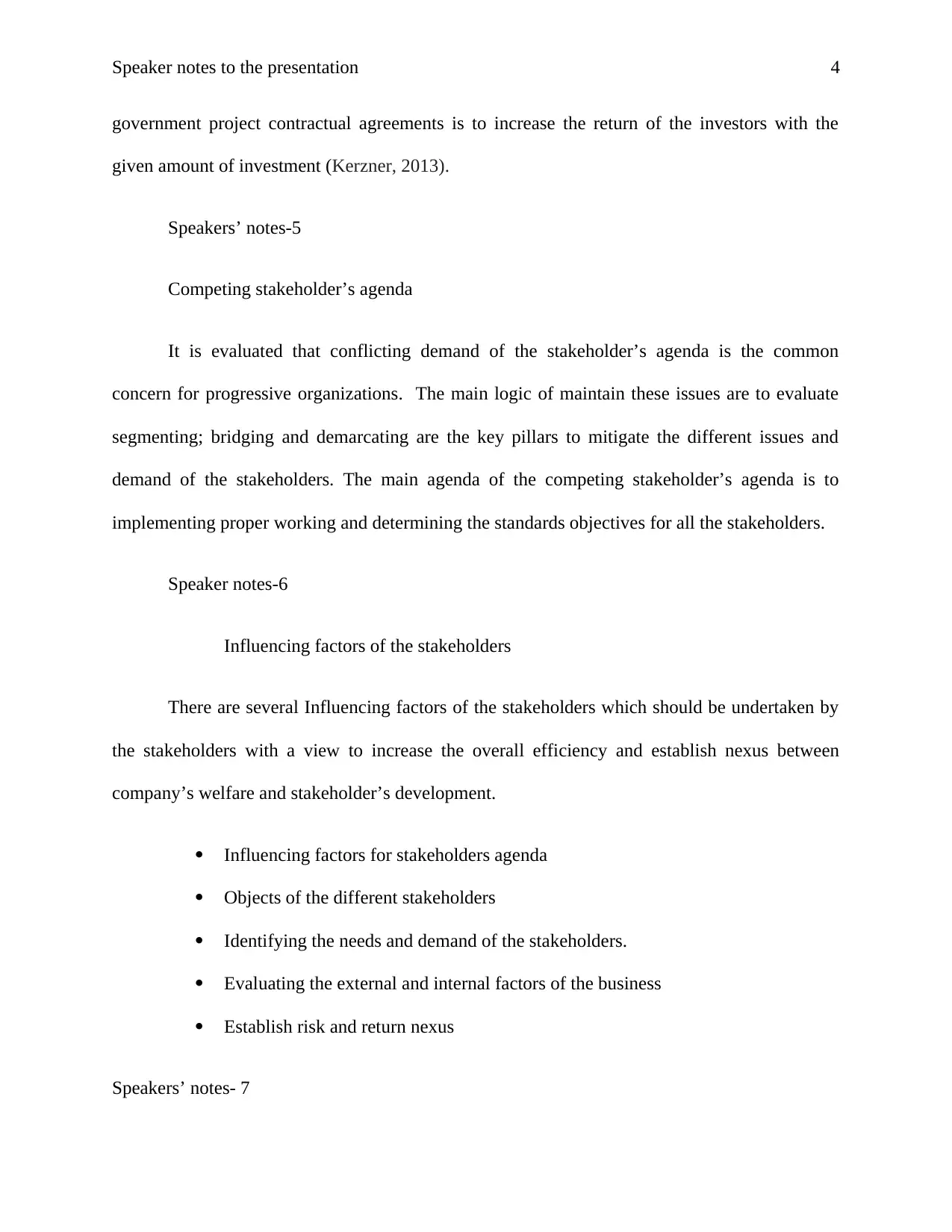
Speaker notes to the presentation 4
government project contractual agreements is to increase the return of the investors with the
given amount of investment (Kerzner, 2013).
Speakers’ notes-5
Competing stakeholder’s agenda
It is evaluated that conflicting demand of the stakeholder’s agenda is the common
concern for progressive organizations. The main logic of maintain these issues are to evaluate
segmenting; bridging and demarcating are the key pillars to mitigate the different issues and
demand of the stakeholders. The main agenda of the competing stakeholder’s agenda is to
implementing proper working and determining the standards objectives for all the stakeholders.
Speaker notes-6
Influencing factors of the stakeholders
There are several Influencing factors of the stakeholders which should be undertaken by
the stakeholders with a view to increase the overall efficiency and establish nexus between
company’s welfare and stakeholder’s development.
Influencing factors for stakeholders agenda
Objects of the different stakeholders
Identifying the needs and demand of the stakeholders.
Evaluating the external and internal factors of the business
Establish risk and return nexus
Speakers’ notes- 7
government project contractual agreements is to increase the return of the investors with the
given amount of investment (Kerzner, 2013).
Speakers’ notes-5
Competing stakeholder’s agenda
It is evaluated that conflicting demand of the stakeholder’s agenda is the common
concern for progressive organizations. The main logic of maintain these issues are to evaluate
segmenting; bridging and demarcating are the key pillars to mitigate the different issues and
demand of the stakeholders. The main agenda of the competing stakeholder’s agenda is to
implementing proper working and determining the standards objectives for all the stakeholders.
Speaker notes-6
Influencing factors of the stakeholders
There are several Influencing factors of the stakeholders which should be undertaken by
the stakeholders with a view to increase the overall efficiency and establish nexus between
company’s welfare and stakeholder’s development.
Influencing factors for stakeholders agenda
Objects of the different stakeholders
Identifying the needs and demand of the stakeholders.
Evaluating the external and internal factors of the business
Establish risk and return nexus
Speakers’ notes- 7
Paraphrase This Document
Need a fresh take? Get an instant paraphrase of this document with our AI Paraphraser
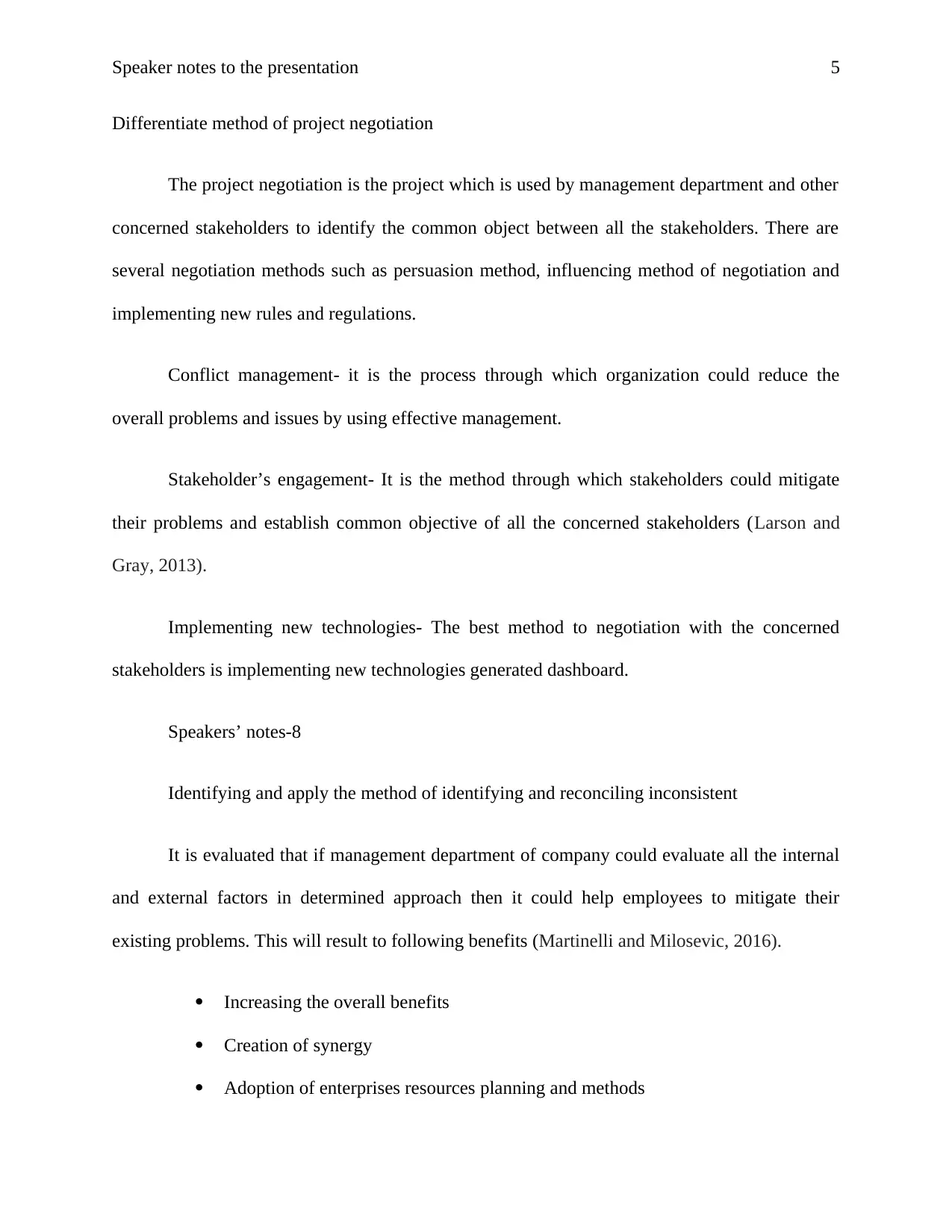
Speaker notes to the presentation 5
Differentiate method of project negotiation
The project negotiation is the project which is used by management department and other
concerned stakeholders to identify the common object between all the stakeholders. There are
several negotiation methods such as persuasion method, influencing method of negotiation and
implementing new rules and regulations.
Conflict management- it is the process through which organization could reduce the
overall problems and issues by using effective management.
Stakeholder’s engagement- It is the method through which stakeholders could mitigate
their problems and establish common objective of all the concerned stakeholders (Larson and
Gray, 2013).
Implementing new technologies- The best method to negotiation with the concerned
stakeholders is implementing new technologies generated dashboard.
Speakers’ notes-8
Identifying and apply the method of identifying and reconciling inconsistent
It is evaluated that if management department of company could evaluate all the internal
and external factors in determined approach then it could help employees to mitigate their
existing problems. This will result to following benefits (Martinelli and Milosevic, 2016).
Increasing the overall benefits
Creation of synergy
Adoption of enterprises resources planning and methods
Differentiate method of project negotiation
The project negotiation is the project which is used by management department and other
concerned stakeholders to identify the common object between all the stakeholders. There are
several negotiation methods such as persuasion method, influencing method of negotiation and
implementing new rules and regulations.
Conflict management- it is the process through which organization could reduce the
overall problems and issues by using effective management.
Stakeholder’s engagement- It is the method through which stakeholders could mitigate
their problems and establish common objective of all the concerned stakeholders (Larson and
Gray, 2013).
Implementing new technologies- The best method to negotiation with the concerned
stakeholders is implementing new technologies generated dashboard.
Speakers’ notes-8
Identifying and apply the method of identifying and reconciling inconsistent
It is evaluated that if management department of company could evaluate all the internal
and external factors in determined approach then it could help employees to mitigate their
existing problems. This will result to following benefits (Martinelli and Milosevic, 2016).
Increasing the overall benefits
Creation of synergy
Adoption of enterprises resources planning and methods
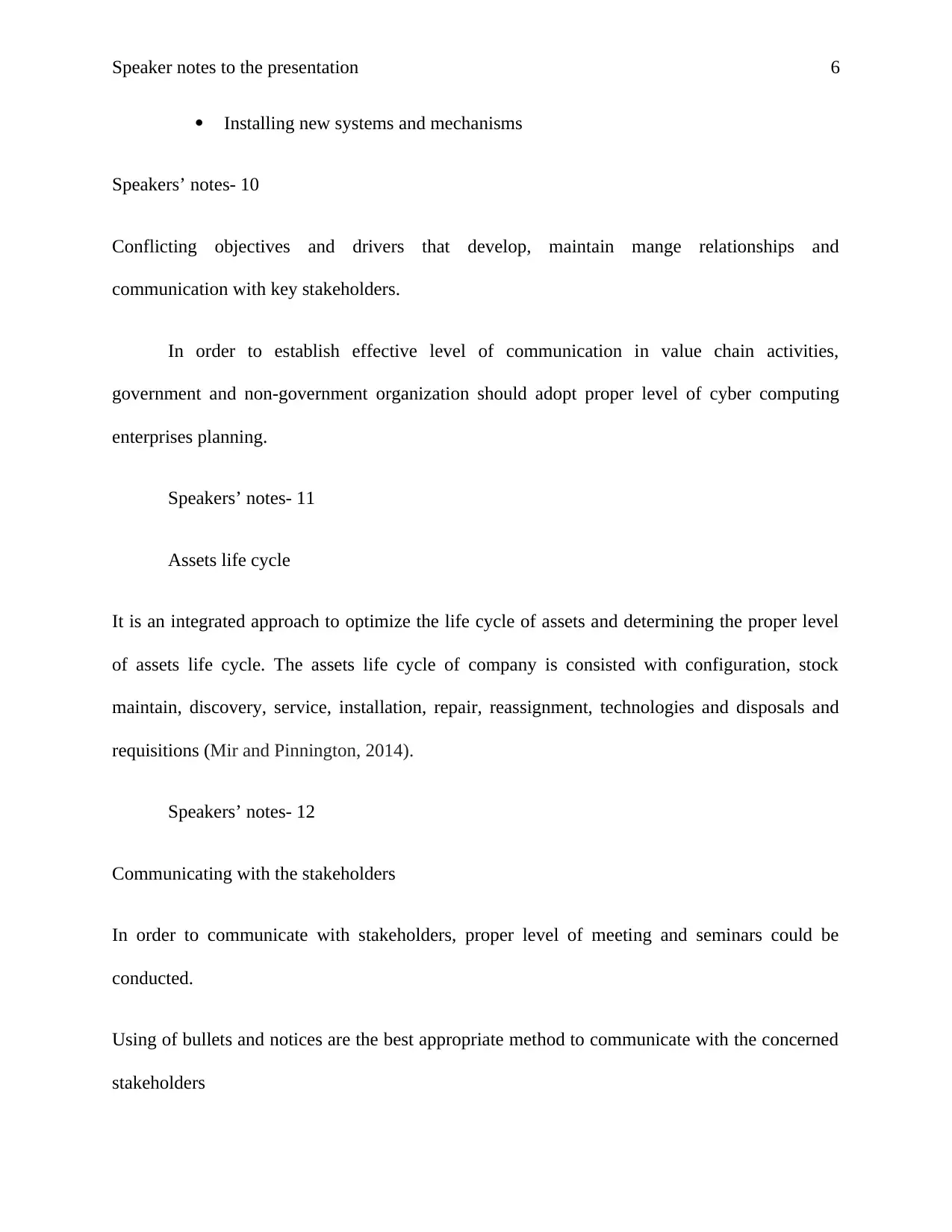
Speaker notes to the presentation 6
Installing new systems and mechanisms
Speakers’ notes- 10
Conflicting objectives and drivers that develop, maintain mange relationships and
communication with key stakeholders.
In order to establish effective level of communication in value chain activities,
government and non-government organization should adopt proper level of cyber computing
enterprises planning.
Speakers’ notes- 11
Assets life cycle
It is an integrated approach to optimize the life cycle of assets and determining the proper level
of assets life cycle. The assets life cycle of company is consisted with configuration, stock
maintain, discovery, service, installation, repair, reassignment, technologies and disposals and
requisitions (Mir and Pinnington, 2014).
Speakers’ notes- 12
Communicating with the stakeholders
In order to communicate with stakeholders, proper level of meeting and seminars could be
conducted.
Using of bullets and notices are the best appropriate method to communicate with the concerned
stakeholders
Installing new systems and mechanisms
Speakers’ notes- 10
Conflicting objectives and drivers that develop, maintain mange relationships and
communication with key stakeholders.
In order to establish effective level of communication in value chain activities,
government and non-government organization should adopt proper level of cyber computing
enterprises planning.
Speakers’ notes- 11
Assets life cycle
It is an integrated approach to optimize the life cycle of assets and determining the proper level
of assets life cycle. The assets life cycle of company is consisted with configuration, stock
maintain, discovery, service, installation, repair, reassignment, technologies and disposals and
requisitions (Mir and Pinnington, 2014).
Speakers’ notes- 12
Communicating with the stakeholders
In order to communicate with stakeholders, proper level of meeting and seminars could be
conducted.
Using of bullets and notices are the best appropriate method to communicate with the concerned
stakeholders
⊘ This is a preview!⊘
Do you want full access?
Subscribe today to unlock all pages.

Trusted by 1+ million students worldwide
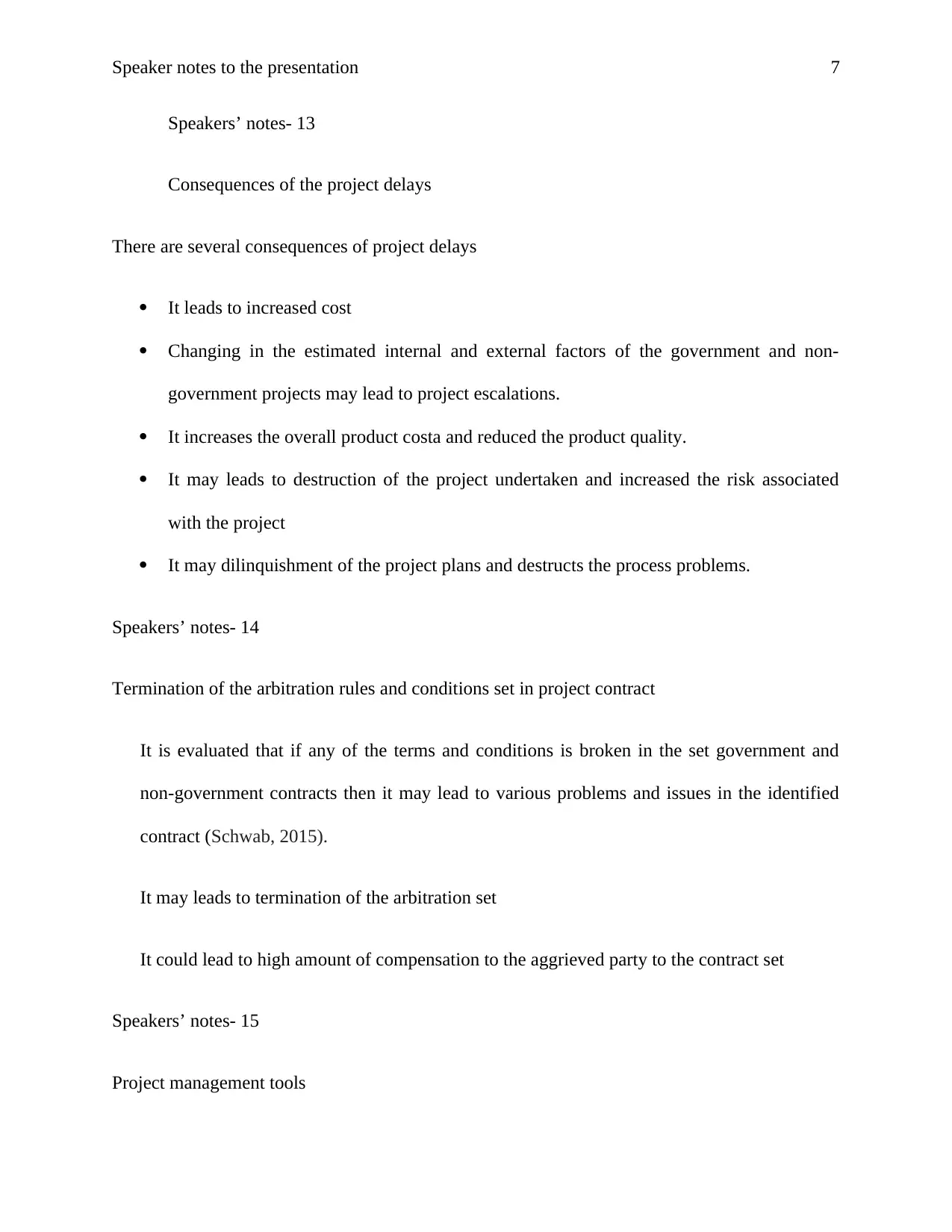
Speaker notes to the presentation 7
Speakers’ notes- 13
Consequences of the project delays
There are several consequences of project delays
It leads to increased cost
Changing in the estimated internal and external factors of the government and non-
government projects may lead to project escalations.
It increases the overall product costa and reduced the product quality.
It may leads to destruction of the project undertaken and increased the risk associated
with the project
It may dilinquishment of the project plans and destructs the process problems.
Speakers’ notes- 14
Termination of the arbitration rules and conditions set in project contract
It is evaluated that if any of the terms and conditions is broken in the set government and
non-government contracts then it may lead to various problems and issues in the identified
contract (Schwab, 2015).
It may leads to termination of the arbitration set
It could lead to high amount of compensation to the aggrieved party to the contract set
Speakers’ notes- 15
Project management tools
Speakers’ notes- 13
Consequences of the project delays
There are several consequences of project delays
It leads to increased cost
Changing in the estimated internal and external factors of the government and non-
government projects may lead to project escalations.
It increases the overall product costa and reduced the product quality.
It may leads to destruction of the project undertaken and increased the risk associated
with the project
It may dilinquishment of the project plans and destructs the process problems.
Speakers’ notes- 14
Termination of the arbitration rules and conditions set in project contract
It is evaluated that if any of the terms and conditions is broken in the set government and
non-government contracts then it may lead to various problems and issues in the identified
contract (Schwab, 2015).
It may leads to termination of the arbitration set
It could lead to high amount of compensation to the aggrieved party to the contract set
Speakers’ notes- 15
Project management tools
Paraphrase This Document
Need a fresh take? Get an instant paraphrase of this document with our AI Paraphraser
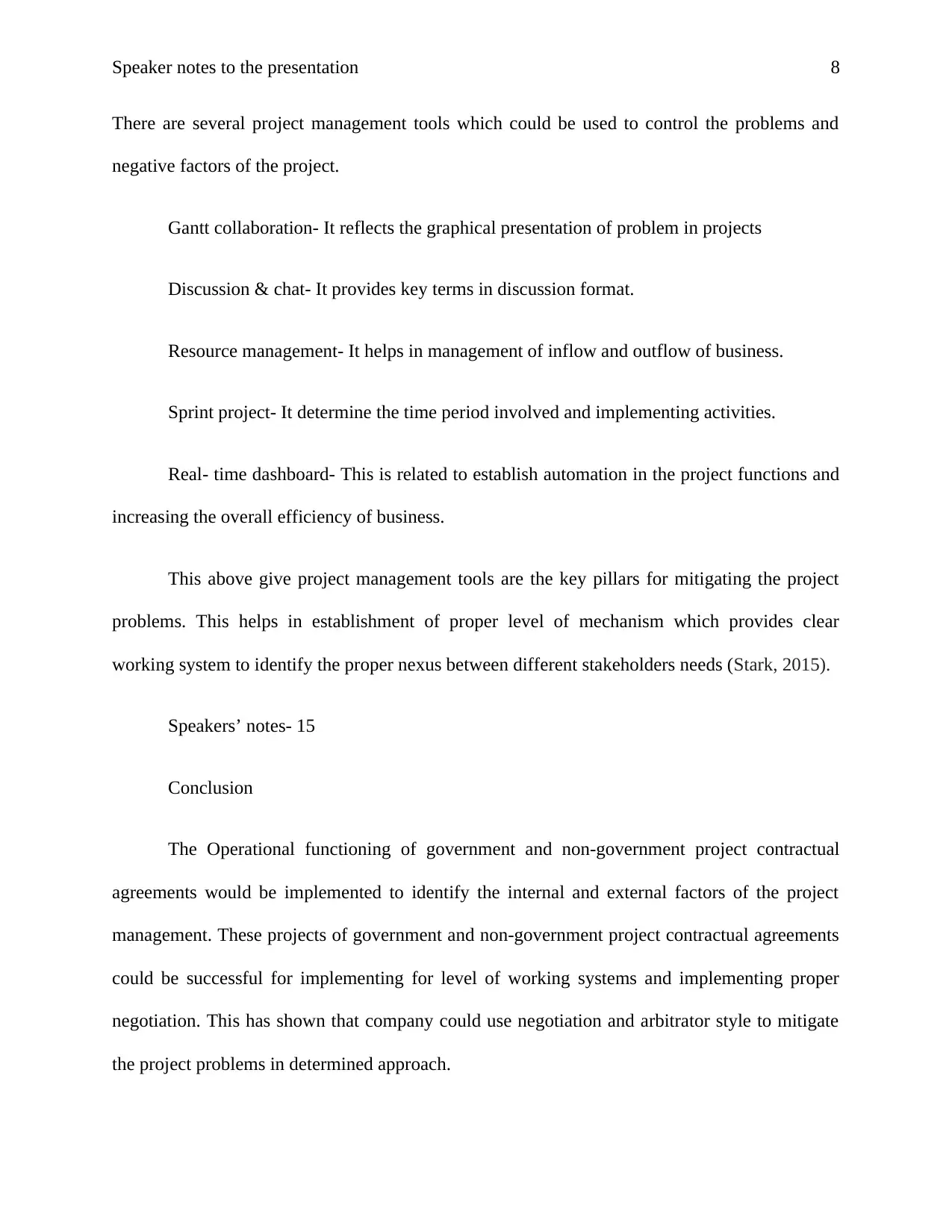
Speaker notes to the presentation 8
There are several project management tools which could be used to control the problems and
negative factors of the project.
Gantt collaboration- It reflects the graphical presentation of problem in projects
Discussion & chat- It provides key terms in discussion format.
Resource management- It helps in management of inflow and outflow of business.
Sprint project- It determine the time period involved and implementing activities.
Real- time dashboard- This is related to establish automation in the project functions and
increasing the overall efficiency of business.
This above give project management tools are the key pillars for mitigating the project
problems. This helps in establishment of proper level of mechanism which provides clear
working system to identify the proper nexus between different stakeholders needs (Stark, 2015).
Speakers’ notes- 15
Conclusion
The Operational functioning of government and non-government project contractual
agreements would be implemented to identify the internal and external factors of the project
management. These projects of government and non-government project contractual agreements
could be successful for implementing for level of working systems and implementing proper
negotiation. This has shown that company could use negotiation and arbitrator style to mitigate
the project problems in determined approach.
There are several project management tools which could be used to control the problems and
negative factors of the project.
Gantt collaboration- It reflects the graphical presentation of problem in projects
Discussion & chat- It provides key terms in discussion format.
Resource management- It helps in management of inflow and outflow of business.
Sprint project- It determine the time period involved and implementing activities.
Real- time dashboard- This is related to establish automation in the project functions and
increasing the overall efficiency of business.
This above give project management tools are the key pillars for mitigating the project
problems. This helps in establishment of proper level of mechanism which provides clear
working system to identify the proper nexus between different stakeholders needs (Stark, 2015).
Speakers’ notes- 15
Conclusion
The Operational functioning of government and non-government project contractual
agreements would be implemented to identify the internal and external factors of the project
management. These projects of government and non-government project contractual agreements
could be successful for implementing for level of working systems and implementing proper
negotiation. This has shown that company could use negotiation and arbitrator style to mitigate
the project problems in determined approach.

Speaker notes to the presentation 9
⊘ This is a preview!⊘
Do you want full access?
Subscribe today to unlock all pages.

Trusted by 1+ million students worldwide
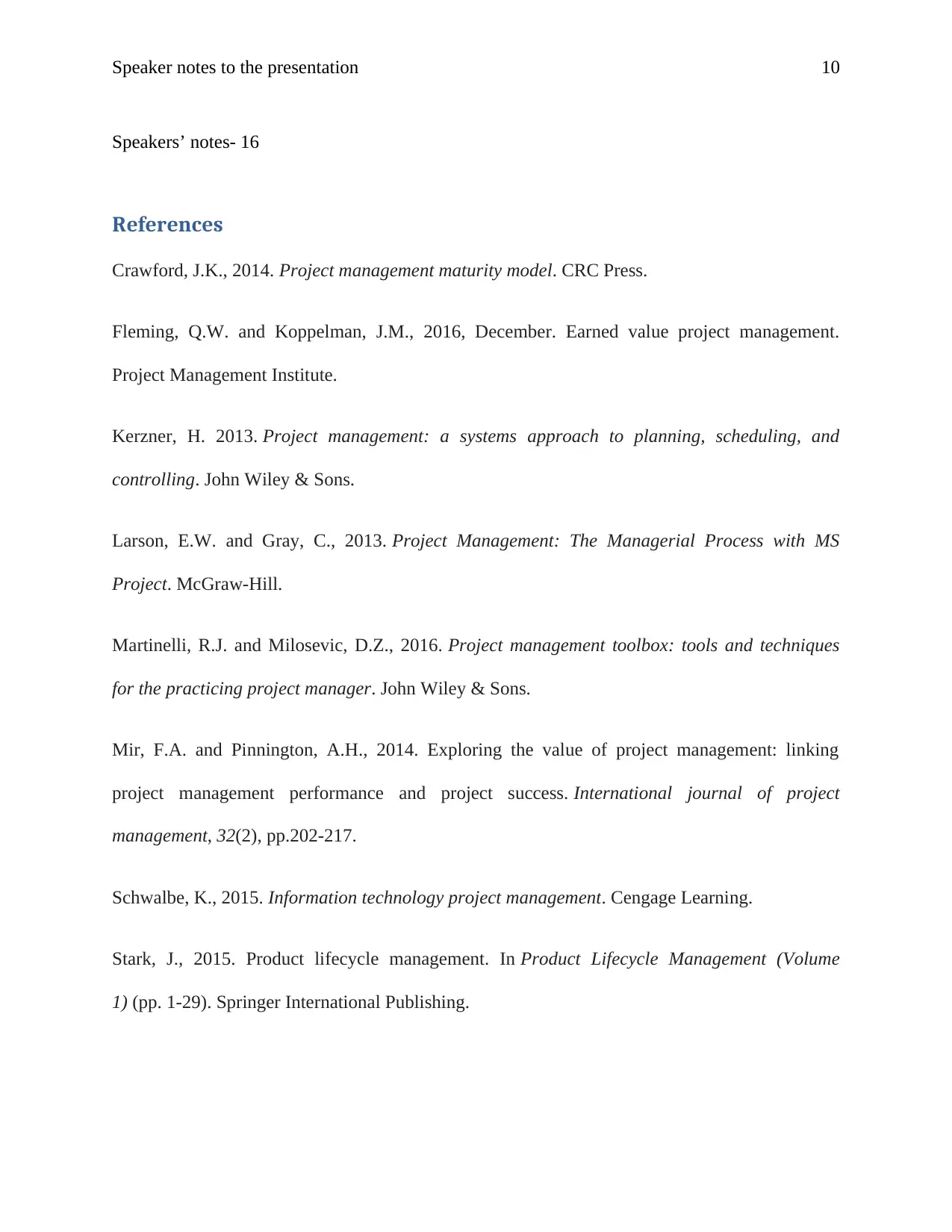
Speaker notes to the presentation 10
Speakers’ notes- 16
References
Crawford, J.K., 2014. Project management maturity model. CRC Press.
Fleming, Q.W. and Koppelman, J.M., 2016, December. Earned value project management.
Project Management Institute.
Kerzner, H. 2013. Project management: a systems approach to planning, scheduling, and
controlling. John Wiley & Sons.
Larson, E.W. and Gray, C., 2013. Project Management: The Managerial Process with MS
Project. McGraw-Hill.
Martinelli, R.J. and Milosevic, D.Z., 2016. Project management toolbox: tools and techniques
for the practicing project manager. John Wiley & Sons.
Mir, F.A. and Pinnington, A.H., 2014. Exploring the value of project management: linking
project management performance and project success. International journal of project
management, 32(2), pp.202-217.
Schwalbe, K., 2015. Information technology project management. Cengage Learning.
Stark, J., 2015. Product lifecycle management. In Product Lifecycle Management (Volume
1) (pp. 1-29). Springer International Publishing.
Speakers’ notes- 16
References
Crawford, J.K., 2014. Project management maturity model. CRC Press.
Fleming, Q.W. and Koppelman, J.M., 2016, December. Earned value project management.
Project Management Institute.
Kerzner, H. 2013. Project management: a systems approach to planning, scheduling, and
controlling. John Wiley & Sons.
Larson, E.W. and Gray, C., 2013. Project Management: The Managerial Process with MS
Project. McGraw-Hill.
Martinelli, R.J. and Milosevic, D.Z., 2016. Project management toolbox: tools and techniques
for the practicing project manager. John Wiley & Sons.
Mir, F.A. and Pinnington, A.H., 2014. Exploring the value of project management: linking
project management performance and project success. International journal of project
management, 32(2), pp.202-217.
Schwalbe, K., 2015. Information technology project management. Cengage Learning.
Stark, J., 2015. Product lifecycle management. In Product Lifecycle Management (Volume
1) (pp. 1-29). Springer International Publishing.
Paraphrase This Document
Need a fresh take? Get an instant paraphrase of this document with our AI Paraphraser

Speaker notes to the presentation 11
‘
:
‘
:
1 out of 11
Related Documents
Your All-in-One AI-Powered Toolkit for Academic Success.
+13062052269
info@desklib.com
Available 24*7 on WhatsApp / Email
![[object Object]](/_next/static/media/star-bottom.7253800d.svg)
Unlock your academic potential
Copyright © 2020–2025 A2Z Services. All Rights Reserved. Developed and managed by ZUCOL.


